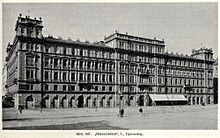Heinrichshof (Vienna)
The Heinrichshof (originally also Heinrichhof) was a Vienna Ringstrasse building that was partially destroyed in 1945 by Allied bombing and after lengthy discussions about a possible reconstruction it was demolished in the 1950s.
history
The Heinrichshof was commissioned by the Viennese brick industrialist Heinrich von Drasche-Wartinberg as a noble apartment building and built from 1861 to 1863. Theophil von Hansen , a Dane, acted as the architect , who also built several other important structures in the area of the Ringstrasse - the stock exchange , the parliament , the Palais Ephrussi , the Palais Epstein and the Musikverein building . The frescoes between the windows on the upper floors were painted by Carl Rahl . The caryatids (sculptures) at Heinrichhof were made by Franz Melnitzky , a sculptor from the early days of the Ringstrasse Palais. They were the work of a master who tried himself out as an architectural sculptor for the first time and thus determined his style. In ever closer collaboration with Hansen, Melnitzky has decorated a number of the Ringstrasse Palais, as well as other buildings in the inner city, with his sculptural decoration. The Heinrichshof was directly opposite the Vienna State Opera . The then famous Café Heinrichhof was located on the ground floor , popular with guests of the opera and nearby theaters, singers, composers and others. The Café Heinrichhof, unlike well-known artist and literary cafés, was considered a café for music, opera and operetta lovers. As a rule, music was mainly played on the piano in this coffee house.
Since 1864, this building has housed the British Bible Society's Biblical Depot , headed by Edward Millard , with a shop. From there, in cooperation with the Evangelical Church , the Bible was organized in the Habsburg Monarchy. Millard's family also had an apartment in this building, and this was where the oldest Baptist congregation met .
During the Second World War , some Nazi offices were housed here. Larger parts of the Heinrichshof were destroyed in the American bombing raid of March 12, 1945, which also caused severe damage to other important buildings in this area of the city such as the Kunsthistorisches Museum , the Burgtheater and the Albertina ; the State Opera and the neighboring Philipphof burned down. On April 27, 1945, parts of the building burned down from suspected arson . Larger parts, such as Elisabethstrasse 2 and parts of the front to Kärntner Strasse (with around 20 tenants) remained largely intact due to the very solid building fabric. Although a rebuilding of the destroyed part of the Heinrichshof was still being sought in July 1949, a demolition notice was issued to the owners on August 12, 1949, and differences broke out within the owner family regarding the preservation or demolition of the building. From a monument preservation point of view, preservation of the building, which was considered to be the “most beautiful apartment building in Vienna”, seemed desirable, but the excellent location and the better commercial usability spoke in favor of a new building. A demolition permit was issued on July 3, 1954.
In 1955, the Opernringhof was built on the same site according to plans by the architects Carl Appel , Georg Lippert and Alfred Obiditsch .
literature
- Heinrichhof in the Vienna History Wiki of the City of Vienna
- Dieter Klein , Martin Kupf , Robert Schediwy : Stadtbildverluste Wien . Vienna 2005, ISBN 3-8258-7754-X
- Heinrichshof , in: Old and New Vienna in its Buildings , edited by Karl Weiss, 2nd edition, Vienna 1865, p. 142 (Google digitized version )
Web links
- suf.at - Heinrichshof and Opernringhof
- Photo Heinrichshof (inverted; undated) on the website of the Main Association of the Austrian Book Trade , which was based in Heinrichshof from 1925 to 1933.
Individual evidence
Coordinates: 48 ° 12 ′ 7.3 " N , 16 ° 22 ′ 6.7" E

